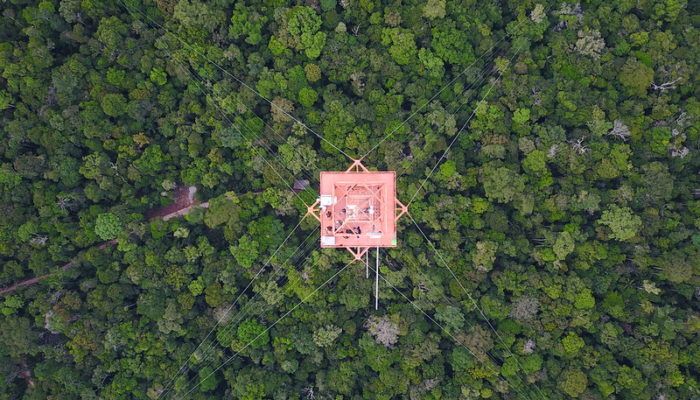
It looks like a spike, orange against the blue sky, sticking out the green ocean of the Amazon forest: Standing 325 m tall, the Amazon Tall Tower Observatory (ATTO) is the highest construction in South America. This tower celebrates its 5th anniversary this year, while the ATTO research site, located ~150 km northeast of Manaus, Brazil, has been in operation for 10 years.
During the past 5 years, I regularly visited the ATTO site, making atmospheric measurements for my PhD. Of course, I myself didn’t experience the beginnings of the project. I only know from the stories of the ATTO pioneers how the accommodations back then consisted of a plastic tarp erected over some hammocks. How the only means of transport to get from the Uatumã River to the first site used to be your own feet and two quad bikes, the latter mainly loaded with luggage. How termites ate the wooden floor of the first lab containers. Nowadays, ATTO feels like a home in the middle of the wilderness. Yes, we still sleep in hammocks, and various kinds of animals such as tarantulas and geckoes can always be expected to visit the dorm or bathrooms. But we now have high tech instrumentation sitting in air-conditioned, quite termite-safe lab containers, we have a roof above our heads and showers in the bathroom, we have satellite internet and TV, and several pick-up trucks are available to transport us and our luggage. While the first atmospheric measurements at the site were made at a 81 m mast, you can now find several towers and masts there, including the 325 m tall tower. Transformation has been a constant at the site since its establishment. The logistics of making all of this possible at such an inaccessible location are an incredible joint effort of Brazilian and German cooperation partners. They brought every single item, including vehicles, construction equipment and all tower parts, by ship via the Uatumã River, which only carries enough water for the transport of heavy goods during the rainy season.
The idea for the project, originating from a “pipe dream” (M. Andreae), is to study biogeochemical cycles in the Amazon forest, its interaction with the soil beneath and the atmosphere above. The research teams “strive to close a gap in the global climate monitoring network and hope to gain deeper insight into the fundamental concepts of gas exchange and cloud formation in tropical rainforests. With the findings from the Amazon Tall Tower Observatory we want to improve climate prediction models and to recognize the importance of the Amazon within the climate system.” (Cited from attoproject.org.)
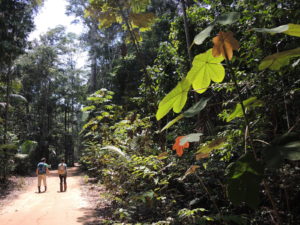
Scientists on their way back to the camp from one of the towers. Photo: Eva Pfannerstill, Creative Commons license (CC BY-NC 4.0)
When you are at ATTO, you will find researchers climbing up the towers to maintain atmospheric measurements or collect samples, others climbing up the trees to put sensors in mosses, walking in the forest to map trees, digging holes in the soil, sitting at a microscope or a screen in one of the lab containers, dragging a gas bottle behind them in a cart along the paths through the forest, setting up new or disassembling malfunctioning instrumentation. Manufacturer support is far away and the internet connection is slow – so creativity in troubleshooting is one thing you definitely learn when working at a remote place like the ATTO site.
The pleasant atmosphere among the ATTO crew and scientists from various countries is one of the reasons why people like to come back here despite the hardships and dangers of working at a remote location in tropical heat and humidity. The beauty and uniqueness of the Amazon forest is certainly another reason why one can fall in love with the ATTO site. Falling asleep in a hammock while hearing the symphony of frogs and cicadas, being awakened by the calls of howling monkeys, spotting river dolphins and fruit-picking toucans, or meeting an armadillo in front of a lab container are experiences I’ll never forget. Any wildlife sighting is made more special by the fact that the rainforest, while full of noise, is hiding its many inhabitants very well. Like many first-time visitors to Amazonia, I expected it to look more like a National Geographic documentary filled with colorful flowers and animals. However, below the canopy, what you see is mostly brown, green, and twilight. Any flowers usually blossom on top of the trees, and most animals are clever enough to hide well before a clumsy scientist stomps across their path.
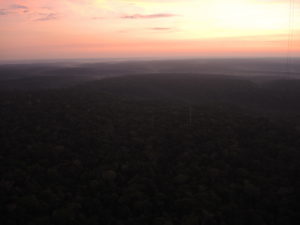
Sunrise seen from the top of the ATTO Tower. The little “toothpick” right of the center is an 80 m walk-up tower. Photo: Eva Pfannerstill, Creative Commons license (CC BY-NC 4.0)
We scientists at ATTO are privileged to be able to leave the humid twilight of the canopy and climb up to the 320 m platform, getting the stunning view of nothing but forest, clouds and rivers till the horizon. Hopefully, the knowledge about the importance of the Amazon for our planet’s wellbeing, also generated here at ATTO, will make us humans preserve this biome, so that the forest will remain – even when this research site is history one day.
—
More information on the ATTO site can be found here including a collection of publications resulting from ATTO research. Please also check out the ATTO special issue in ACP!

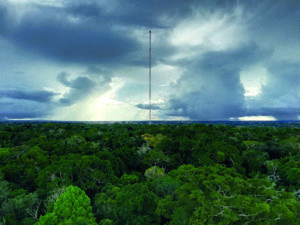

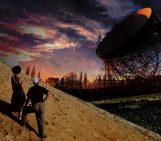


Krishnakanth k
Im very much excited to work .. how to apply for this ?
EP
You can find job opportunities at the ATTO project here: https://www.attoproject.org/opportunities/